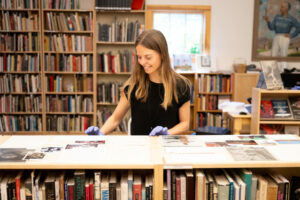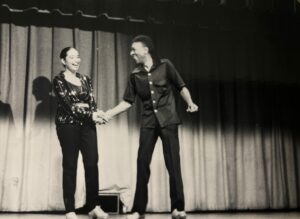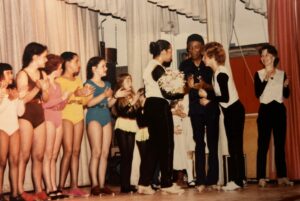By Isabel Brandt
Isabel Brandt is a 2024 Archiving and Preservation Fellow with Dianne Walker. Read more about the Fellowships here. This is the second part of Isabel’s blog. Read the first part here.
Legacy in the Inventory
- Dianne Walker and Leon Collins
- Dianne Walker, Leon Collins C.B. Heatherington, and Pamela Raff at the 2nd Annual Dance Performance of Leon Collins Dance Studio, produced by Dianne Walker. June 26th, 1982 in Brookline, Massachusetts.
Legacy is at the core of archiving and preservation. It is upheld through the transmission of knowledge and tradition and systematically safeguarded through archival practices. This theme of legacy has been particularly relevant in working with Dianne Walker’s archives. Dianne values the stories of her mentors as highly as her own, with their legacies framing her history and her role in the tap dance field. In turn, she has inherited their knowledge and wisdom, acting as a repository for their histories. This inherent lineage, seen in the tradition of dancers passing down wisdom through generations, resonates deeply with me as a dancer myself.

Performance program for the 2nd Annual Dance Performance of Leon Collins Dance Studio, June 26th, 1982 in Brookline, Massachusetts.
I have always cherished my dance lineage, which connects me to iconic modern dancers, just as my family tree links me to my ancestors. To honor this concept in Dianne’s archives, I realized that a standard, high-level inventory might not capture her lineage as effectively as a detailed item-level inventory would. Given the limited time to organize and inventory Dianne’s collection, I was able to create more detailed records for only some items. To achieve this, I focused on defining the relationships and experiences highlighted in Dianne’s storytelling.
To organize Dianne’s archives, I implemented a system that categorizes materials by type, providing a structured framework for the inventory. However, to truly capture the essence of her legacy and provide deeper context, I included detailed item-level descriptions where they would be most impactful. By incorporating specific details, such as related entities and dates, I aimed to provide meaningful context that reflects both the organizational structure and the personal significance of each item. For example, items such as collected newspaper clippings of Leon Collins and programs from his dance studio are linked through metadata, or data about data, demonstrating his significance in Dianne’s career. This approach ensures the inventory reflects Dianne’s values and effectively frames the elements of tap dance lineage.

Left to right: Jeannie Hill, Fred Strickler, Mindy Copeland, Dianne Walker, Lia Spirka, Kylie (last name unknown) at the San Jose Tap Festival in 1998.
In addition to the inventory work required for the collection’s donation to a repository, my time with Dianne has given me insight into tap dance as an art form and its history through the lens of her remarkable career. Given the nuanced and creative nature of this project, my discussions with Dianne have helped align the archival work with her teaching and legacy goals. As these conversations progress, I am looking forward to establishing relationships with repositories to ensure the continued preservation of Dianne’s legacy.
All photos courtesy of Dianne Walker.
Header image: Left to right: Bernard Manners, Dianne Walker, Melvin Washington, Ivery Wheeler backstage for the production of Black and Blue – Théâtre du Châtelet, Paris, France, 1985.

Isabel Brandt is currently pursuing a Master’s Degree in Library and Information Science at Pratt Institute with a focus in archival studies. She received her BFA in Dance from The Ohio State University through which she pursued several research projects exploring the process of dance archiving and reconstruction. As an Undergraduate Library Research Fellow, Isabel conducted archival research and created a guide to unprocessed dance scores in the Dance Notation Bureau Collection to explore digital librarianship with dance notation. In 2022, she presented her research abroad to an international community of dance archivists and researchers at the conferences of the International Council of Traditional Music (ICTM) and the International Council of Kinetography Laban (ICKL). As an Archives and Audience Engagement intern with Jacob’s Pillow Dance Festival, Isabel furthered her expertise in archival reference, exhibition development, finding aid cataloging, and archival processing. Isabel is drawn to the unique, collaborative, and creative nature of dance archiving and is excited to explore how the archivist role can center artistic voice and identity.
Photo credit: Christopher Duggan
____
We accept submissions on topics relevant to the field: advocacy, artistic issues, arts policy, community building, development, employment, engagement, touring, and other topics that deal with the business of dance. We cannot publish criticism, single-company season announcements, and single-company or single artist profiles. Additionally, we welcome feedback on articles. If you have a topic that you would like to see addressed or feedback, please contact communications@danceusa.org.
Disclaimer: Opinions expressed in guest posts do not necessarily represent the viewpoints of Dance/USA.







